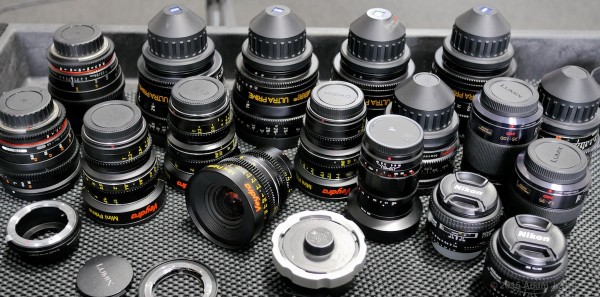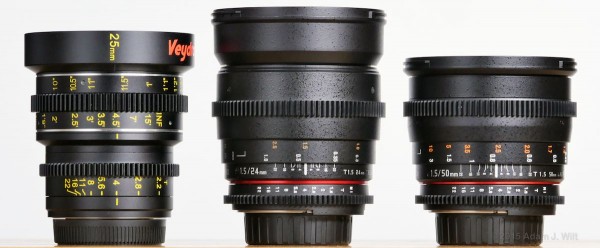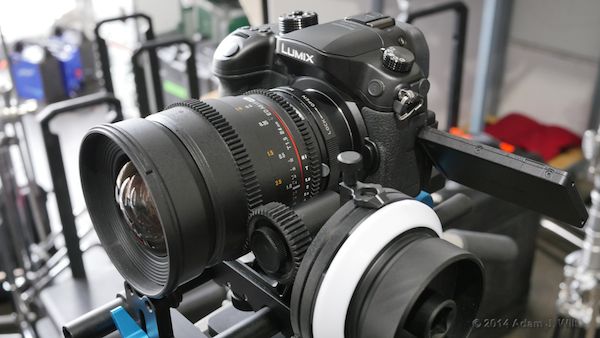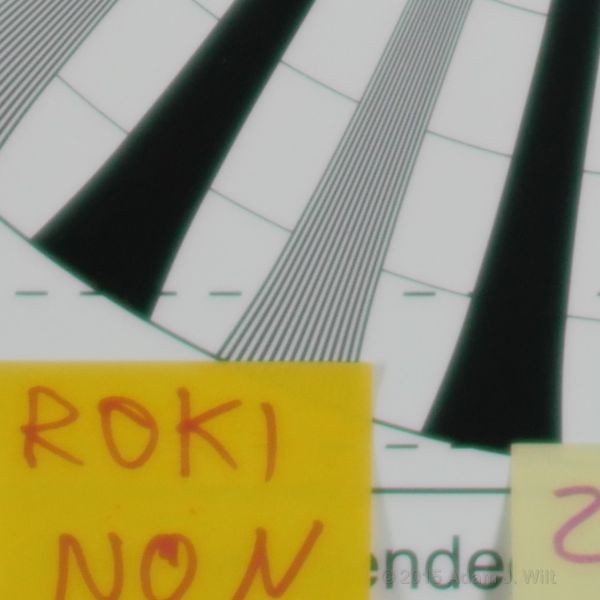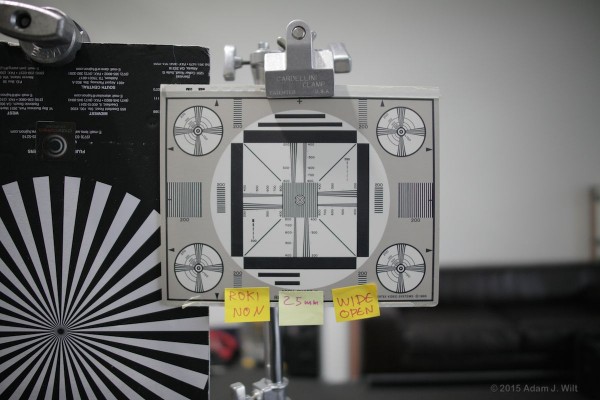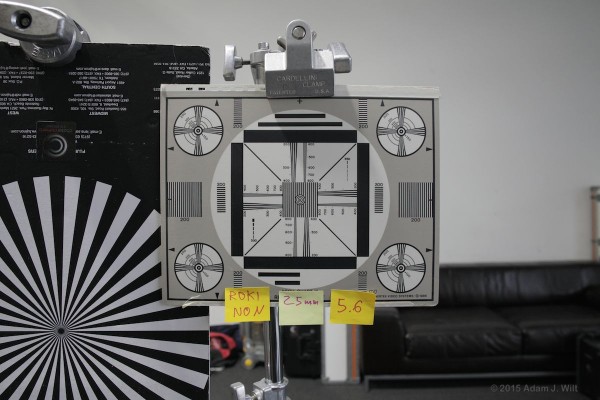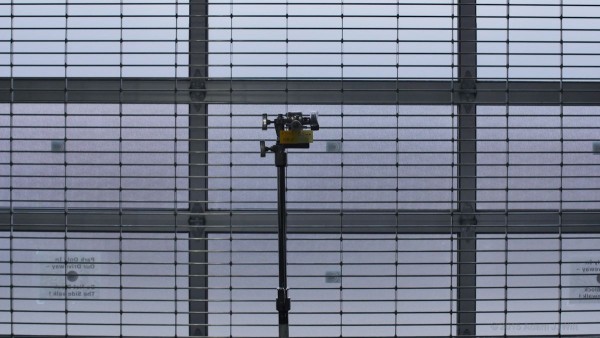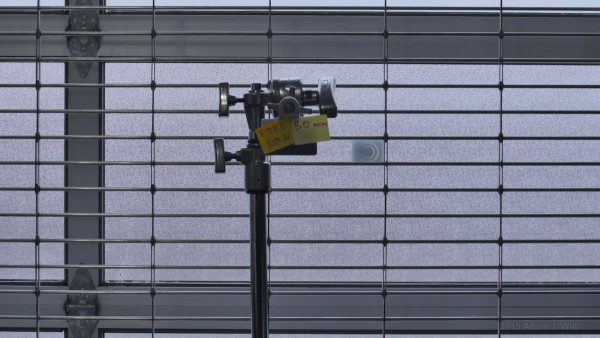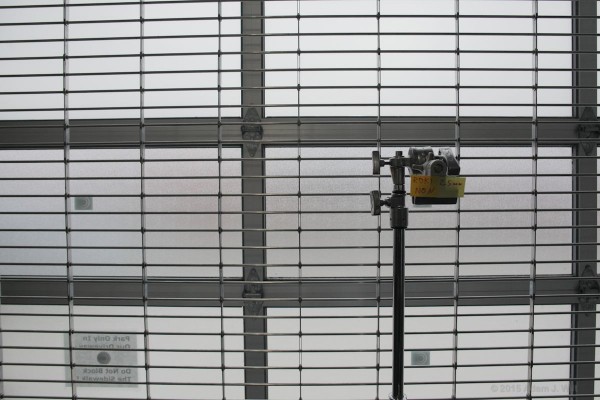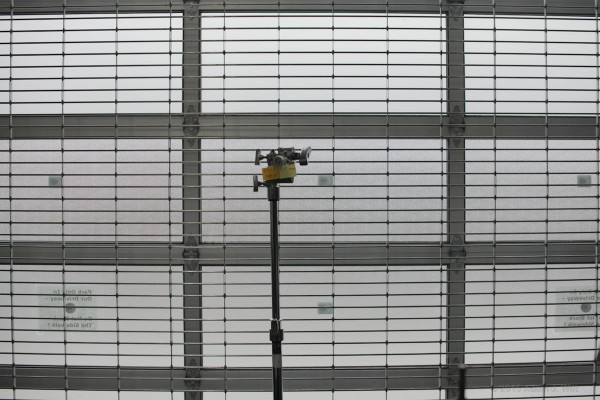Last December I did a series of side-by-side test with a variety of lenses on my GH4: T1.9 Ultra Primes, T1.3 Mk II Super Speeds, and T2.2 Veydras, all dedicated cine primes; two T1.5 Rokinon DS cine primes, based on still-camera lenses; Nikon and Voightlander still primes; and the Lumix 12-35mm and 35-100mm still zooms.
I’ve already written up the Veydras on PVC, described the tests here on DVInfo, and posted a 311 MB zipfile of stills and an 825 MB, 8:23 video clip of focus pulls if you’d like to pixel-peep the results yourself. Here, I’m going to look at the highly affordable Rokinon Cine Primes.
The tests were triggered by the sudden and unexpected availability of prototype Veydras. I used that as an excuse to rent some Rokinons, and compare both sets of lenses against cine glass I knew well (Ultra Primes and Super Speeds, courtesy of Chater Camera) and the still lenses I use all the time, because I’m dissatisfied with the still lenses I use all the time.
Don’t get me wrong: I love the Lumix 12-35mm and 35-100mm f/2.8 lenses – for stills. They’re pin-sharp, rectilinear, and aberration-free. They autofocus in the blink of an eye and have optical stabilization. Their modest 3x zoom ratios allow focal-length flexibility without falling into the jack-of-all-focal-lengths-master-of-none compromises of still-camera superzooms.
For run’n’gun video, too, they’re fine. The short-throw, fly-by-wire focusing is fine for racking focus on the move. But for more careful, preplanned work, they’re limited to fixed-focus, fixed-focal-length shots at constant aperture. Focus pulling? Fuggedaboudit. With no marks and no repeatability, a clean cine-style pull from one mark to another is simply not possible. Their annoying tendency to reset to infinity when the camera sleeps or shuts off makes ‘em even more obstreperous when attempting precision work.
Fine: how about a fully manual still-camera lens? I have the Voightlander Nokton f/0.95 in my kit. Old-school mechanical focus with a 270º throw! Duclos makes a set of cine-modded Noktons, but I have the stills version (I can fit a rubber gear belt for my follow-focus, but it can slip a bit… and at f/0.95, depth of field is really thin). I also have a couple of Nikon primes, the 50mm f/1.4 D and the 35mm f/2 D, with 120º focus throws and spartan scales with perhaps seven distances lurking behind peek-a-boo windows (I have a variety of Canon and Nikon zooms and Canon primes with similar controls, though I didn’t drag them into this test).
Finding – and hitting – focus marks is a trial with any of these lenses, and I have plenty of blown shots to prove it.
The Veydras offer a unique value: true cine-style primes, complete with cine gearing, long-throw focusing, and high-visibility markings, for around $1000/lens.
However, they’re MFT (micro four thirds) only, so if you’re not in the Panasonic, Olympus, BMPCC, or GY-LS300 camp, they won’t do you a lick of good. And they are nearly a kilobuck each, so they aren’t exactly impulse buys – not if you want to collect the whole set.
So, if you aren’t dedicated to living in the MFT ghetto, and you haven’t got upwards of $3000/lens to spend on Zeiss Compact Primes, Sony CineAlta Lenses, Canon CN-Es, and the like (and if you do, Matthew Duclos discusses your options), you’ll probably want to look at Rokinons.
Rokinons (also sold under Samyang, Bower, Walimex, Vivitar, and other labels) are low-cost, Korean-built, fully-manual lenses, available in both still and cine flavors. The cine primes are converted still lenses, with focus and iris gears added and with the aperture declicked for smoother iris pulls. Once again, Matthew Duclos has a great intro to them. I rented lenses in the “DS” series, with consistent focus/iris gear positioning and side scales. Prices run from $350 to $800; the 24mm is the priciest one of the bunch at $800 while the 50mm is $600 (non-DS lenses tend to be $50 less, but they’re being phased out).
I rented two Rokinons, the 24mm T1.5 and the 50mm T1.5, both in Nikon F mount. Why F? It’s the most universal of still-cam lens mounts; there are adapters from F to Canon EF, MFT, and Sony E-mount readily available, so the lens is as close to universally usable as possible. I already had an F-to-MFT adapter for my GH4, and I rented an F-to-Canon-EF adapter so I could stick the Rokis on my 5D Mk II.
One immediate disappointment: the F-mount version stays true to Nikon tradition and focuses “backwards” compared to most other still cameras and standard video / cine practice. The Canon EF, Sony E-mount, and MFT versions all focus “properly” by cine standards, so if you need “proper” focusing, I’d suggest the EF mount as the most flexible choice.
Mechanics
Build quality is best described as perfectly adequate: plastic housings with pebbly finishes; smoothly-turning focus and iris rings with no hangups or stiff spots. Lens mounts are metal, and solidly attached. I’m not sure the lenses would stand up to heavy-handed abuse, but they don’t feel overly fragile. I’ve had a $350 Vivitar Series 1 85mm f/1.4 in EF mount for few years, which is from the same manufacturer and has the same general build, as well as a Rokinon MFT 7.5mm f/3.5 fisheye, and they’ve held up very well (but I take care of my lenses, so I’m not a good source of test-to-destruction data).
Bear in mind that these are solid mechanical lenses: no finicky focus motors or iris actuators, no need for fragile focus-group positioners drivable by an autofocus system. They don’t have a lot of fiddly bits inside to go wrong.
The biggest mechanical failing on these lenses is the lens hood attachments. Small tabs on the hood engage slots on the lens barrel, but these tabs fit rather loosely and pop out of their slots at the slightest provocation, sending the hood bouncing across the floor, usually within a few seconds of having mounted it.
Optical Performance
Wide open at T1.5, the Rokinons behave much like other “superspeed” lenses wide open, including the Nokton 25mm f/1.85, the Nikon 50mm f/1.4 D, and the Zeiss T1.3 Superspeeds. They’re all reasonably sharp in the center and less so towards the edges due to coma, while the entire image has a slight haziness or “glow” caused by longitudinal chromatic aberration, most noticeable as green/purple fringing. It’s a hazy, “soapy”, or “dreamy” look, not a precise, crisp, clinical look.
The Rokinons, also in common with their fast brethren, have a tendency to vignette somewhat at wide apertures: corners are darker than the center wide open, though the difference diminishes as you close iris down a stop or two (the samples below are from a Canon 5D Mk II; the GH4 images crop in about 2x and so show a less dramatic vignette, though it’s still visible. S35mm/APS-C would be in between these extremes).
These aspects – which add character if you like them, and are defects if you don’t – diminish as you stop the lenses down. All the lenses I tested look pretty much identical by T4 or T5.6 as far as these characteristics are concerned; all look crisp and contrasty from edge to edge. If there’s a difference in this regard, it’s that more expensive lenses cleaned up faster: most of the primes were as crisp and contrasty as they could get within a stop or two at the worst, while the Rokinons didn’t hit their peak sharpness until T4 or T5.6.
Distortion is more of a concern: both the 24mm and the 50mm show more barrel distortion that any of the other lenses I tested in those focal ranges. For MFT it’s not too bad:
However it’s fairly extreme on the full-frame 5D Mk II:
Again, a Super35mm / APS-C sensor’s image would be about halfway between those examples. (And yes, the Canon 50mm shot looks “wider” than the 24mm shot, since I had to reposition quite a bit further away for that one photo, for reasons that now elude me.)
Whether it’s a problem depends on your aesthetics and what you like to shoot: not an issue with hobbits in hobbit-holes, more troublesome if you’re remaking Tati’s Play Time. It also seems to vary across the product line: the 14mm and 16mm are frequently called out for excessive distortion, while the 12mm is comparatively clean based on online reviews. The 85mm is pretty darned rectilinear; the 35mm is said to be quite good, too.
Bokeh – the quality of out-of-focus imagery – is very good on these two lenses: smooth, even blobs of light. The 24mm’s blobs are nicely round and feathered at the edges, while the 50mm has sharper-edged bokeh with a hint of the octagonal iris opening at mid-apertures.
Flare seemed well-controlled and generally comparable to the other primes in my test.
Lateral chromatic aberration (color fringing in the corners) isn’t an issue at all with these lenses.
Download the aforementioned zipfiles if you want to ogle the full set of tests.
Operation
Focus and iris controls are smooth and predictable, and need an appropriate amount of force: you won’t strain to turn either one (wobbling the camera in the process), neither will you screw up focus with an accidental touch. I didn’t record the focus throw on the Rokinons, but it was definitely shorter (required less rotation) than on purpose-built cine primes like the Veydras or Ultra Primes. Hitting a mark precisely can be tricky as a result of the short throw, but it wasn’t unmanageable. The focus and iris gears are in exactly the same place across all the DS lenses (see Matt Duclos’ graphic if you haven’t already) so there’s no need to reposition follow-focuses or motors when you swap lenses.
Compared to the still-camera Rokinons, the DS lenses move focus and iris scales to the side of the lens, cine-style, where a focus puller can more easily see them. The focus marks include depth-of-field indicators, a rarity even on still lenses these days. The DoF marks would be more useful if the focus scales were more densely populated; the far half of the 50mm’s Imperial scale runs 2.0’, 2.5’, 3.5’, 5’, 10’, and ∞, with plenty of empty space in between the distances.
With such scanty numbering, I found I was using the DoF indicators as my marks: instead of putting my desired distance opposite the witness line, I might see that 10’ was opposite the upper f/16 limit line, and use that instead.
Markings in general, while better oriented for cine work than on a still lens, are more driven by style than readability. The numbers are small, and the Imperial scale (for those of us in the decadent west who still use it) is in low-contrast dull orange paint, farther from the witness line than the high-contrast white metric scale. Additionally, the lens identification, e.g., “1.5/50mm” is marked in relatively small type, on the lower side of the barrel between the focus and iris rings. It’s a lot harder to grab a Rokinon out of a case and see what you’ve got at a glance than it is with an Ultra Prime, Cooke, or other modern cine prime, all of which have big, bold focal-length markings on the barrel.
Focus and iris gears may be consistent across the set, but little else is: max apertures run from T1.5 to T3.8, so if you’ve lit for T2 on the 24mm and need to switch to the 14mm T3.1, you’ll be hurting for light (in fairness, everything from 24mm through 85mm is T1.5). Lens lengths and diameters vary across the set. If you use screw-in filters, you’ll need a bunch of different sizes; if you use a matte box, you’ll have to reposition it on every lens change, and probably swap the doughnut or gasket while you’re at it.
Conclusion
Still lenses are crafted in isolation from each other; their lengths, front diameters, control placements, and maximum apertures are all optimized for each individual lens without particular regard to how those parameters play out on other lenses, though lenses within a lineup often use the same diameter screw-in filters. Most modern still lenses offer short focus throws, minimalist focusing scales (if any), and fly-by-wire focus and iris.
With purpose-built cine primes, it’s important that they excel optically, mechanically, and operationally, but they must also play well together as a set. Cine lenses have long-throw mechanical focusing rings with well-populated and highly visible scales, manually-controllable apertures without click-stops or jumpy steps, and gearing to accept motors or follow-focuses. They are engineered to have comparable optical performance and “character”, so that you can swap lenses without worrying about a change in the overall look of the image. Primes are frequently changed, so those within a lineup tend to have the same length, front diameter, and gear positions, so that swaps can happen without changing filters sizes or repositioning matte boxes and accessories. Consistent max apertures mean you can change focal lengths without worrying about suddenly “losing the light” due to the lens.
Rokinon Cine Primes, and other cine-modded still lenses from Duclos or SLR Magic, are interesting half-breeds: they offer the smooth, geared, manual focus and iris controls of cine lenses grafted onto the individualistic designs of standalone still lenses. They solve the biggest operational problems of still lenses in cine/video production, though their differing sizes complicate quick changes when matte boxes and filters are involved, and their unique rendering qualities, such as varying distortion or bokeh, may reduce the consistency of the look across lens swaps.
Clearly, all else being equal, you’d want purpose-built cine primes. But all else is rarely equal: cine primes are pricey. At the low end, Veydras run about $1000/lens, but they only work on MFT cameras. Hong Kong’s SLR Magic has embarked on a series of true cine primes designed to cover full-frame 24x36mm sensors, rumored to run about $2000/lens; Sony CineAltas run about $3500 each in a set of six; Zeiss Compact Primes start at $4000/lens and go up from there; Cooke minis start at $7850 each; Ultra Primes run about $14K each; Master Primes will set you back $23K. Each.
Rokinon Cine DS lenses average a mere $570, and a five-lens set – 14, 24, 35, 50, & 85mm – is under $2900. Four of the five are T1.5 while the 14mm is T3.1. A $600 135mm T2.2 is expected in February. It’s hard to argue that they don’t provide value for money.
If you’re shooting cine-style with still lenses, Rokinons offer a massive step up in ergonomics and functionality. Combined with a proper follow-focus, Rokis let you pull focus consistently and repeatably. Their stepless, declicked apertures work just like those on “real” cine lenses, so you can dial in precisely the iris setting you need, and pull exposure smoothly during a take with no hops, skips, or jumps. From 24mm to 85mm they open to T1.5, for super-shallow depth of field and for eking the most out of low light situations.
Do they have the consistency and interoperability of dedicated cine glass? No. You’ll need to reposition your matte box on lens changes; distortion and bokeh will vary more between Rokis than between Veydras or Ultra Primes or Cookes; go wider than 24mm or longer than 85mm and your maximum aperture will shrink. But at $570 each, it would be small of me to complain too vigorously.
Rokinons are readily and affordably available from LensRentals and BorrowLenses, so you don’t need to take my word for it – or anyone else’s. Grab one or grab a set, try ‘em out over a weekend, and see if they make sense for you.
Pros
- Rokis are the most affordable cine lenses available
- T1.5 from 24mm through 85mm
- Consistent focus / iris gear placement across entire set
- No lateral chromatic aberration to speak of
- Very crisp from T4 onwards
- Depth-of-field scales
Cons
- Inconsistent sizes across the set
- Poor lens hood attachments
- 14mm has fixed lens hood (can’t fit filters; not sure how it work with a matte box)
- small, sparse, hard-to-read focus scales (by cine lens standards)
Cautions
- I only tested the 24mm, 50mm, and an older Vivitar-branded 85mm
- Non DS lenses have focus and aperture scales on top, not sides
- Comparatively soft images wide open
- Shorter focus throw than most cine lenses
- Focus scales lack precise distance marks, and lenses focus past ∞
- Distortion and bokeh characteristics vary across the set
- Nikon F-mount Rokinons focus “backwards” by cine standards
Disclosure: Ryan Avery at Veydra sent me the four Veydra prototypes to look at and answered my questions, but didn’t offer me any special deals or other inducements for a favorable review. Chater Camera let play with their lenses and test charts for free, because they’re exceedingly nice chaps, and they weren’t too busy, and I was quiet and stayed out of the way of paying customers. I rented the Rokinons, the PL mount, and the Nikon/Canon adapter from LensRentals.com. The rest of the kit was my own. There is no material connection between me and Veydra, Rokinon, LensRentals.com, BorrowLenses.com, Chater Camera, Duclos Lenses, or any other vendor mentioned in the article.

